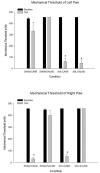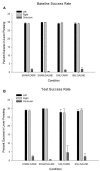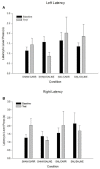The Use of an FR1 Schedule Operant Approach-Avoidance Paradigm to Measure the Aversiveness of Neuropathic and Inflammatory Pain
- PMID: 35295429
- PMCID: PMC8915719
- DOI: 10.3389/fpain.2021.793958
The Use of an FR1 Schedule Operant Approach-Avoidance Paradigm to Measure the Aversiveness of Neuropathic and Inflammatory Pain
Abstract
Pain is a subjective, private, yet universal phenomenon that depends on a unique combination of sensory, affective, and evaluative characteristics. Although preclinical models have been used to understand much of pain physiology, the inability to communicate with animals limits affective and evaluative feedback and has constrained traditional behavioral methods to adequately represent and study the multidimensional pain experience. Therefore, this study sought to characterize the affective component of pain within a novel operant approach-avoidance paradigm (AAP) to determine which type of pain (inflammatory and neuropathic) may be more aversive. To reveal the possible differences in pain aversiveness within the AAP paradigm, animals received bilateral inflammatory and neuropathic pain conditions and were given the choice to a) forgo appetitive reward by not receiving noxious stimulus of either inflammatory or neuropathic conditions or b) receive noxious stimulus in exchange for an appetitive reward. Although all pain conditions produced significant hypersensitivity, the AAP results revealed there was no preference in the stimulation of a specific paw in the bilateral pain conditions. The finding suggests that despite unique clinical pain characteristics for inflammatory and neuropathic conditions, the lack of observable differences in the pain conditions may not necessarily equate to the overall similarity in aversiveness, but rather that the fixed ratio (FR1) paradigm presentation allowed appetitive reward to be more salient, highlighting the complexities of competing motivational drives of pain and hunger when satiating hunger is always guaranteed. Thus, future studies should seek to further tease apart this relationship with a different schedule and food-controlled methodologies. The development of such preclinical approaches can thoroughly investigate the intricacy of competing drives and likely reveal important information regarding the complexity of pain, enhancing our understanding of pain perception in individuals suffering from comorbid pain states.
Keywords: approach; avoidance; inflammation; neuropathy; operant; pain.
Copyright © 2022 Salcido, Argenbright, Aguirre, Trujillo and Fuchs.
Conflict of interest statement
The authors declare that the research was conducted in the absence of any commercial or financial relationships that could be construed as a potential conflict of interest.
Figures




Similar articles
-
Assessing the aversive nature of pain with an operant approach/avoidance paradigm.Physiol Behav. 2018 May 15;189:59-63. doi: 10.1016/j.physbeh.2018.02.053. Epub 2018 Mar 1. Physiol Behav. 2018. PMID: 29501556
-
Evaluation of reward from pain relief.Ann N Y Acad Sci. 2013 Apr;1282:1-11. doi: 10.1111/nyas.12095. Epub 2013 Mar 15. Ann N Y Acad Sci. 2013. PMID: 23496247 Free PMC article. Review.
-
Lesion of the rostral anterior cingulate cortex eliminates the aversiveness of spontaneous neuropathic pain following partial or complete axotomy.Pain. 2011 Jul;152(7):1641-1648. doi: 10.1016/j.pain.2011.03.002. Epub 2011 Apr 6. Pain. 2011. PMID: 21474245 Free PMC article.
-
Resistance of Food-Maintained Operant Responding to Mechanical Punishment in Rats: Further Evidence for Weak "Affective/Motivational Pain" in Rat Models of Inflammatory and Neuropathic Pain.Front Pharmacol. 2021 Jan 29;11:615782. doi: 10.3389/fphar.2020.615782. eCollection 2020. Front Pharmacol. 2021. PMID: 33584295 Free PMC article.
-
Brain circuits for pain and its treatment.Sci Transl Med. 2021 Nov 10;13(619):eabj7360. doi: 10.1126/scitranslmed.abj7360. Epub 2021 Nov 10. Sci Transl Med. 2021. PMID: 34757810 Free PMC article. Review.
Cited by
-
Dorsal column pathway is involved in tactile reward-induced affective 50-kHz ultrasonic vocalizations in rats.PLoS One. 2025 Mar 26;20(3):e0320645. doi: 10.1371/journal.pone.0320645. eCollection 2025. PLoS One. 2025. PMID: 40138331 Free PMC article.
References
-
- Melzack R, Wall PD. Pain mechanisms: a new theory. Pain Forum. (1996) 5:3–11. 10.1016/S1082-3174(96)80062-6 - DOI
LinkOut - more resources
Full Text Sources
Miscellaneous

